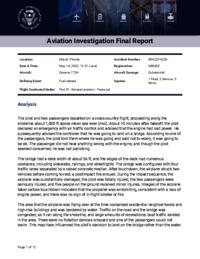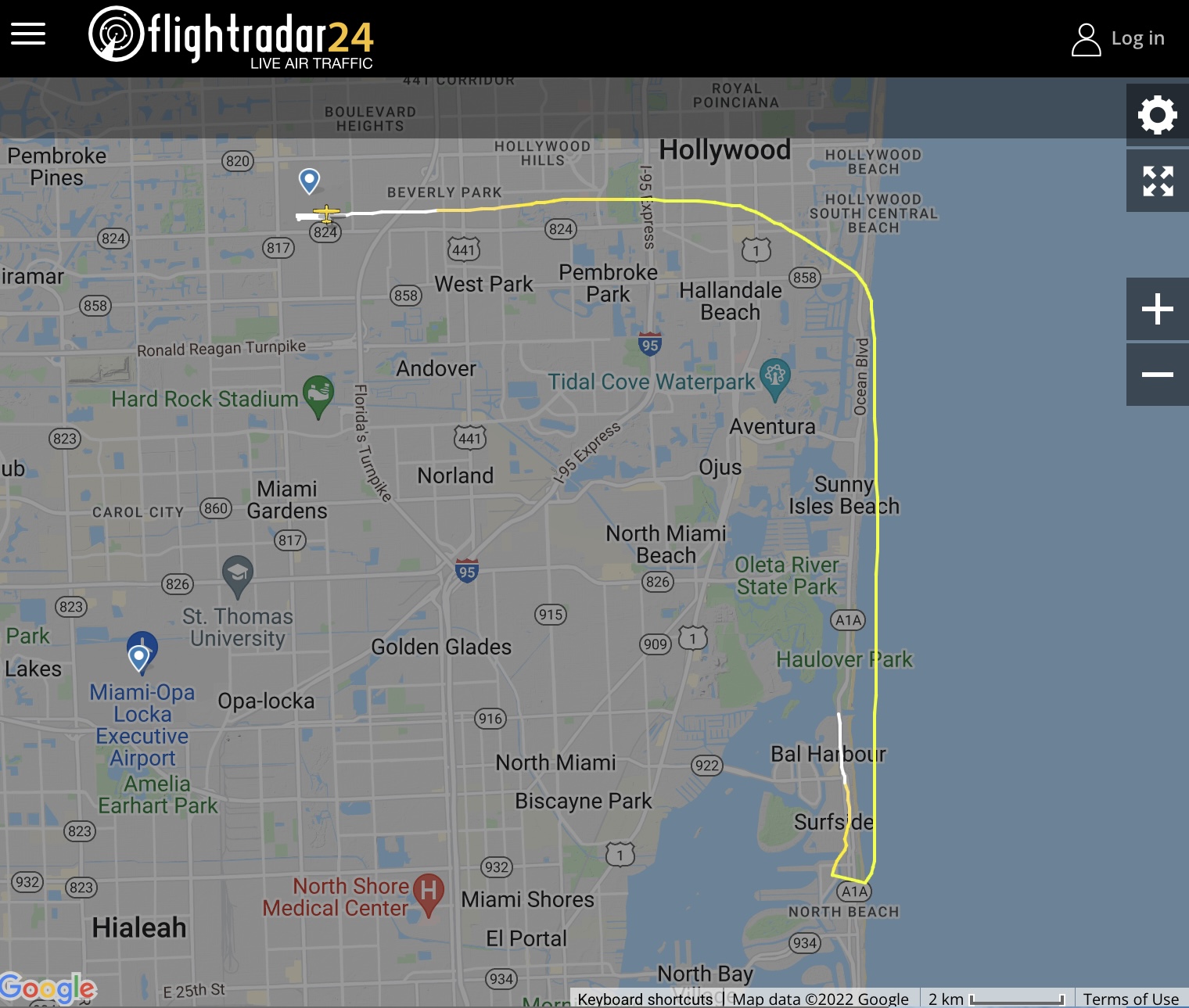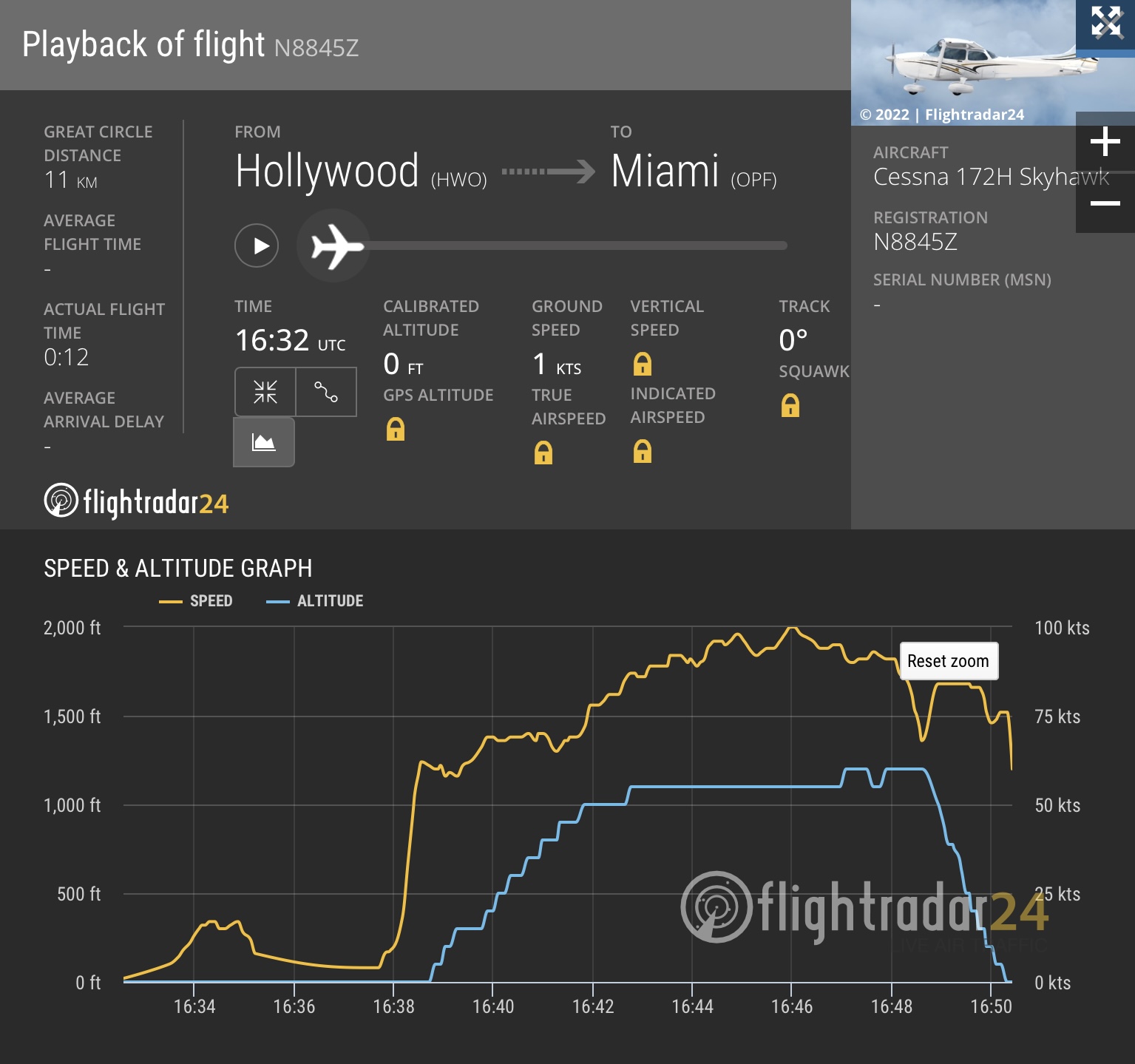
This information is added by users of ASN. Neither ASN nor the Flight Safety Foundation are responsible for the completeness or correctness of this information.
If you feel this information is incomplete or incorrect, you can submit corrected information.
| Date: | Saturday 14 May 2022 |
| Time: | 12:51 |
| Type: |  Cessna 172H Skyhawk |
| Owner/operator: | Private |
| Registration: | N8845Z |
| MSN: | 17255495 |
| Year of manufacture: | 1966 |
| Fatalities: | Fatalities: 1 / Occupants: 3 |
| Other fatalities: | 0 |
| Aircraft damage: | Destroyed |
| Category: | Accident |
| Location: | Miami, FL -
 United States of America United States of America
|
| Phase: | En route |
| Nature: | Private |
| Departure airport: | Hollywood-North Perry Airport, FL (HWO/KHWO) |
| Key West International Airport, FL (EYW/KEYW) | |
| Investigating agency: | NTSB |
| Confidence Rating: |
On May 14, 2022, about 1251 eastern daylight time, a Cessna 172H airplane, N8845Z, was substantially damaged when it was involved in an accident near Miami, Florida. The pilot was fatally injured, two passengers were seriously injured, and five people on the ground received minor injuries. The airplane was operated as a Title 14 Code of Federal Regulations (CFR) Part 91 personal flight.
The pilot and two passengers departed on a cross-country flight, proceeding along the shoreline about 1,000 ft above mean sea level (msl). About 10 minutes after takeoff, the pilot declared an emergency with air traffic control and advised that the engine had lost power. He subsequently advised the controller that he was going to land on a bridge. According to one of the passengers, the pilot told them where he was going and said not to worry, it was going to be ok. The passenger did not hear anything wrong with the engine, and though the pilot seemed concerned, he was not panicking.
The bridge had a deck width of about 56 ft, and the edges of the deck had numerous obstacles, including sidewalks, railings, and streetlights. The bridge was configured with four traffic lanes separated by a raised concrete median. After touchdown, the airplane struck two vehicles before coming to rest; a postimpact fire ensued. During the impact sequence, the airplane was substantially damaged, the pilot was fatally injured, the two passengers were seriously injured, and five people on the ground received minor injuries. Images of the airplane taken before touchdown indicated that the propeller was windmilling, consistent with a loss of engine power, and there was no sign of in-flight smoke or fire.
The area that the airplane was flying over at the time comprised residential neighborhoods and high-rise buildings and was bordered by water. Traffic on the road and the bridge was congested, as it ran along the shoreline, and large amounts of recreational boat traffic existed in the area. There were no flotation devices onboard and one of the passengers could not swim. This may have influenced the pilot’s decision to land on the bridge rather than the water.
Examination of the airframe and engine revealed no evidence of preimpact failures or malfunctions that would have precluded normal operation. The carburetor heat air valve was functional, and the carburetor heat knob was found in the closed (off) position. Although the fuel selector valve was found between the “BOTH” and “RIGHT” fuel tank positions, fuel was found downstream of the fuel selector during the postaccident examination, which indicated that the valve was likely moved after the engine had stopped drawing fuel from the line.
Weather observations indicated that relative humidity exceeded 50% in the area of the accident site and along the route of flight, and review of atmospheric soundings revealed conditions conducive to the development of moderate carburetor icing at the airplane’s altitude. Based on the available information, it is likely that the pilot's failure to use carburetor heat resulted in an accumulation of ice within the carburetor, which subsequently resulted in a total loss of engine power.
Probable Cause: A total loss of engine power due to carburetor ice as a result of the pilot’s failure to effectively use carburetor heat in conditions conducive to the formation of carburetor ice.
Accident investigation:
 |
|
Sources:
https://www.nbcmiami.com/news/local/small-aircraft-on-fire-after-crashing-on-bridge-in-miami/2760742/
https://miami.cbslocal.com/2022/05/14/small-plane-crashed-into-haulover-inlet-bridge/
https://data.ntsb.gov/Docket?ProjectID=105075
https://registry.faa.gov/AircraftInquiry/Search/NNumberResult?nNumberTxt=8845Z
https://globe.adsbexchange.com/?icao=ac2fd0&lat=25.944&lon=-80.196&zoom=13.0&showTrace=2022-05-14&leg=2
https://flightaware.com/live/flight/N8845Z
https://photos-e1.flightcdn.com/photos/retriever/f08fa0b231497a68d1659db484a3e8bc59ef70e7 (photo)
Location
Images:



Photo: NTSB
Media:
A small plane crashed into the Haulover Inlet Bridge | #Onlyindade pic.twitter.com/GWwSUQkd0G
— ONLY in DADE (@ONLYinDADE) May 14, 2022
Revision history:
| Date/time | Contributor | Updates |
|---|---|---|
| 14-May-2022 17:25 | harro | Added |
| 14-May-2022 17:26 | harro | Updated [Time, Embed code, Category] |
| 14-May-2022 17:31 | harro | Updated [Time, Aircraft type, Registration, Cn, Departure airport, Destination airport, Source] |
| 14-May-2022 17:35 | harro | Updated [Operator, Narrative] |
| 14-May-2022 18:07 | RobertMB | Updated [Time, Operator, Total fatalities, Other fatalities, Phase, Nature, Source, Narrative] |
| 14-May-2022 19:52 | Geno | Updated [Total occupants, Location, Phase, Narrative] |
| 14-May-2022 20:54 | Iceman 29 | Updated [Photo] |
| 14-May-2022 20:55 | Iceman 29 | Updated [Photo] |
| 15-May-2022 02:16 | johnwg | Updated [Time, Total fatalities, Phase, Destination airport, Source, Embed code, Narrative, Category] |
| 15-May-2022 07:14 | Iceman 29 | Updated [Embed code] |
| 16-May-2022 15:22 | Iceman 29 | Updated [Embed code] |
| 03-Jun-2022 23:47 | Captain Adam | Updated [Time, Location, Source, Narrative, Category] |
| 28-Jun-2024 17:01 | Captain Adam | Updated [Source, Narrative, Accident report, Photo] |
Corrections or additions? ... Edit this accident description
The Aviation Safety Network is an exclusive service provided by:


 ©2024 Flight Safety Foundation
©2024 Flight Safety Foundation